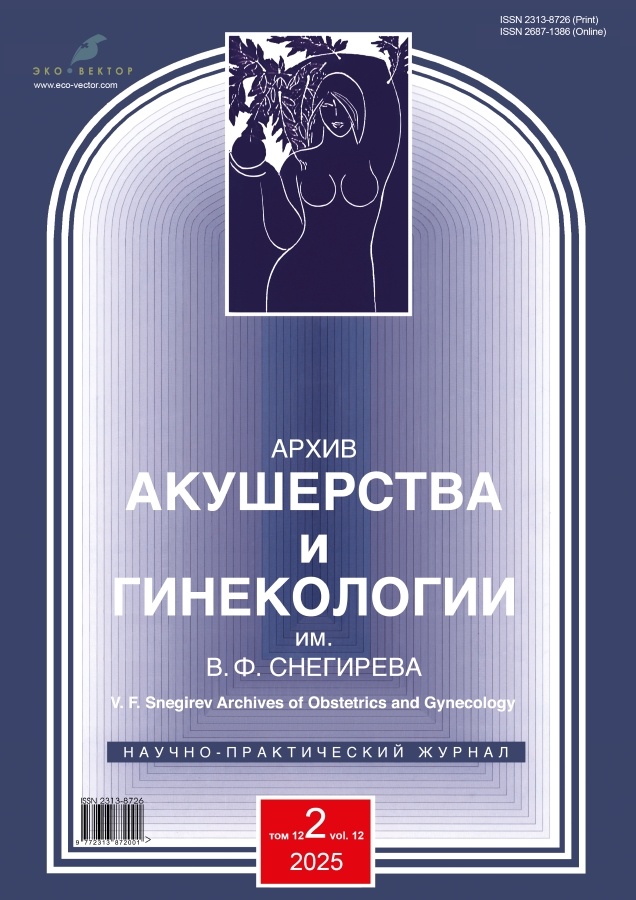Assessment of current options for correction of stress urinary incontinence and pelvic organ prolapse without mesh implants
- Authors: Dobrohotova Y.E.1, Lapina I.A.1, Glebov N.V.2, Kaykova O.V.2, Chirvon T.G.1, Tyan A.G.2, Taranov V.V.1
-
Affiliations:
- Pirogov Russian National Research Medical University
- MEDSI Group of Companies
- Issue: Vol 12, No 2 (2025)
- Pages: 235-245
- Section: Original study articles
- Submitted: 23.01.2025
- Accepted: 07.04.2025
- Published: 10.06.2025
- URL: https://archivog.com/2313-8726/article/view/646578
- DOI: https://doi.org/10.17816/aog646578
- EDN: https://elibrary.ru/FPARIH
- ID: 646578
Cite item
Abstract
Background: Between 40% and 80% of women over the age of 50 experience pelvic organ prolapse of varying clinical severity, often accompanied by stress urinary incontinence. With a growing trend toward abandoning synthetic meshes in pelvic surgery, the search for alternative treatment methods has become a relevant issue.
Aim: To assess the potential for correcting stress urinary incontinence and pelvic organ prolapse without using mesh implants.
Methods: A prospective clinical study included 70 women with varying degrees of pelvic organ prolapse. Patients with stage I prolapse according to the POP-Q classification were included only if they had concomitant complaints of stress urinary incontinence. These patients formed Group 1 (n = 24). Group 2 included patients with stage II–IV pelvic organ prolapse by the POP-Q with mandatory apical compartment descent (n = 46). Patients from each group were divided into subgroups. Subgroup 1A received transurethral injections of fillers, whereas subgroup 1B underwent conventional TVT-O sling placement. In Group 2, two types of surgery were performed according to subgroup assignment: in subgroup 2A, laparoscopic promontofixation of the cervical stump was carried out using a mesh-less technique (native tissues and suture material); in subgroup 2B, conventional laparoscopic sacrocolpopexy with polypropylene mesh was performed.
Results: In Group 1, 12 months after filler injection, clinical efficacy was sustained in 40% of patients, which was more than two times lower than in the mesh sling group (93%). With careful patient selection, fillers may reduce hospital workload by shifting a portion of stage I pelvic organ prolapse patients with stress urinary incontinence symptoms to outpatient care, while lowering the use of foreign implants. In Group 2, the anatomical success rate at 1 month was 92% in subgroup 2A (mesh-less) versus 90% in subgroup 2B (p = 0.265). Although 1-year recurrence rates were comparable between subgroups, long-term follow-up over 5–10 years is necessary for a comprehensive outcome assessment.
Conclusion: Given the minor advantages of various mesh implants in pelvic surgery, their high cost and increasing rates of intra- and postoperative complications have led to a trend toward alternative surgical approaches using autologous tissues and non-surgical injectable therapies in cases of stress urinary incontinence.
Full Text
About the authors
Yulia E. Dobrohotova
Pirogov Russian National Research Medical University
Email: pr.dobrohotova@mail.ru
ORCID iD: 0000-0002-7830-2290
SPIN-code: 2925-9948
MD, Dr. Sci. (Medicine), Professor
Russian Federation, MoscowIrina A. Lapina
Pirogov Russian National Research Medical University
Email: doclapina@mail.ru
ORCID iD: 0000-0002-2875-6307
SPIN-code: 1713-6127
MD, Dr. Sci. (Medicine)
Russian Federation, MoscowNikita V. Glebov
MEDSI Group of Companies
Email: glebov.nikita2@mail.ru
ORCID iD: 0000-0002-7072-6953
Russian Federation, Moscow
Olesya V. Kaykova
MEDSI Group of Companies
Email: kajkova.ov@medsigroup.ru
ORCID iD: 0000-0003-2338-1128
Russian Federation, Moscow
Tatiana G. Chirvon
Pirogov Russian National Research Medical University
Author for correspondence.
Email: tkoltinova@gmail.com
ORCID iD: 0000-0002-8302-7510
MD, Cand. Sci. (Medicine)
Russian Federation, MoscowAnatoliy G. Tyan
MEDSI Group of Companies
Email: doctortyan@yandex.ru
ORCID iD: 0000-0003-1659-4256
SPIN-code: 6960-9405
MD, Cand. Sci. (Medicine)
Russian Federation, MoscowVladislav V. Taranov
Pirogov Russian National Research Medical University
Email: vlastaranov@mail.ru
ORCID iD: 0000-0003-2338-2884
SPIN-code: 6974-0237
MD, Cand. Sci. (Medicine)
Russian Federation, MoscowReferences
- Popov AA, Krasnopolskaya IV, Fedorov AA, et al. Modern mesh implants in genital prolapse surgery. Obstetrics and Gynecology of St. Petersburg. 2018;(3-4):57–58. (In Russ.) EDN: YVCBCN
- Shakhaliev RA, Shulgin AS, Kubin ND, et al. Current status of transvaginal mesh implants use in the surgical treatment of stress urinary incontinence and pelvic prolapse. Gynecology. 2022;24(3):174–180. doi: 10.26442/20795696.2022.3.201423 EDN: ZEDFCS
- Management of mesh and graft complications in gynecologic surgery. Committee Opinion No. 694. American College of Obstetricians and Gynecologists. Obstet Gynecol. 2017;129(4):e102–e108. doi: 10.1097/AOG.0000000000002022
- Wang B, Chen Y, Zhu X, et al. Global burden and trends of pelvic organ prolapse associated with aging women: an observational trend study from 1990 to 2019. Front Public Health. 2022;10:975829. doi: 10.3389/fpubh.2022.975829
- Drutz HP, Alarab M. Pelvic organ prolapse: demographics and future growth prospects. Int Urogynecol J Pelvic Floor Dysfunct. 2006;17 (Suppl 1):S6–S9. doi: 10.1007/s00192-006-0102-1
- Wallace SL, Syan R, Sokol ER. Surgery for apical vaginal prolapse after hysterectomy: transvaginal mesh-based repair. Urol Clin North Am. 2019;46(1):103–111. doi: 10.1016/j.ucl.2018.08.005
- Clinical guidelines: Urinary incontinence. 2024–2025–2026 (07.08.2024). Approved by the Russian Ministry of Health. (In Russ.) URL: http://disuria.ru/_ld/14/1449_kr24N39R32MZ.pdf
- Nutaitis AC, George EL, Mangira CJ, et al. Trends in urogynecologic surgery among obstetrics and gynecology residents from 2002 to 2022. Urogynecology (Phila). 2024;30(1):73–79. doi: 10.1097/SPV.0000000000001385
Supplementary files












